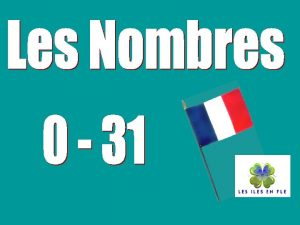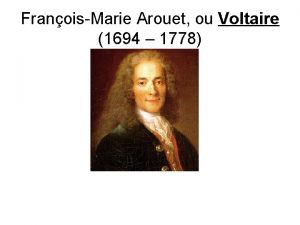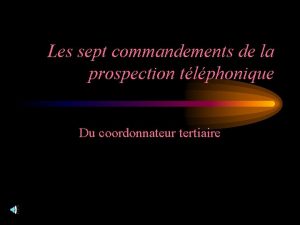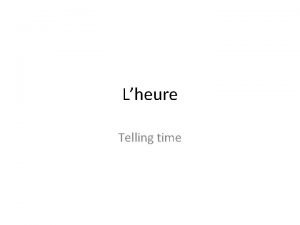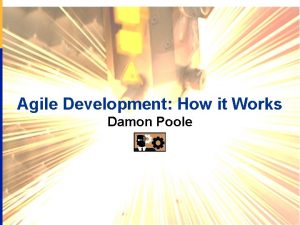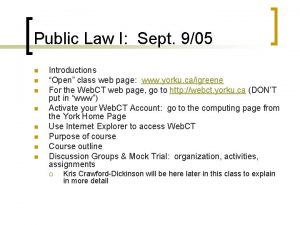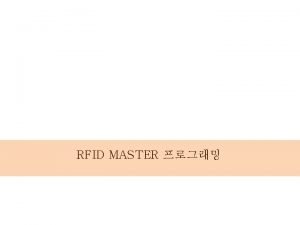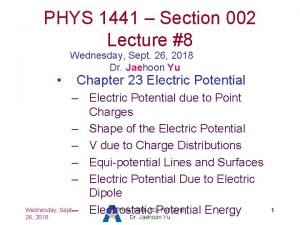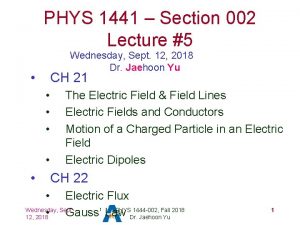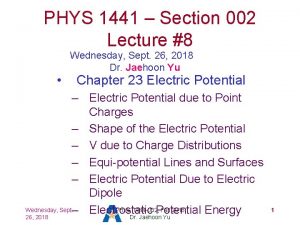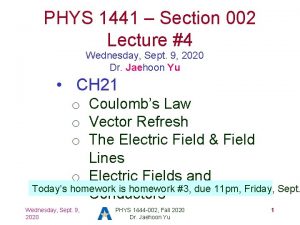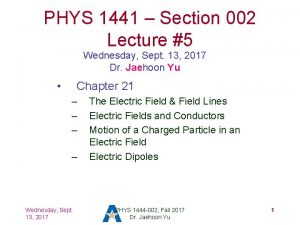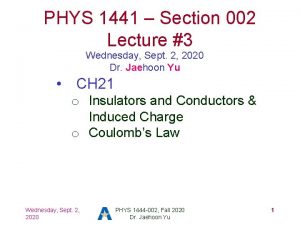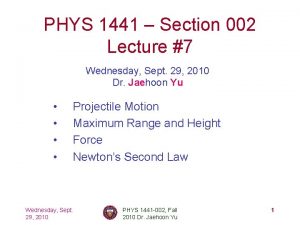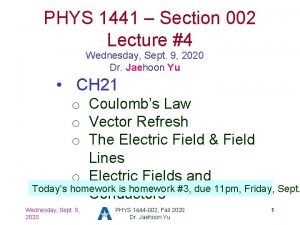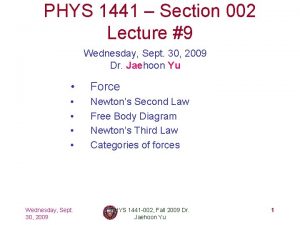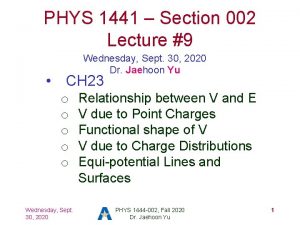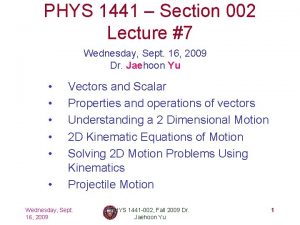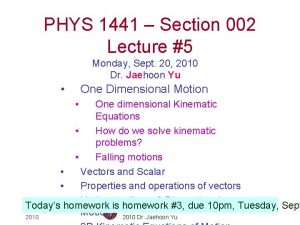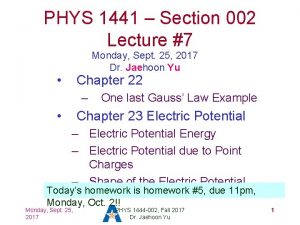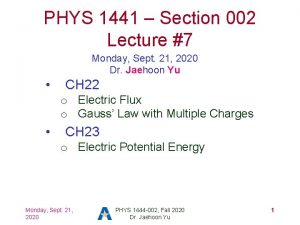PHYS 1441 Section 002 Lecture 6 Wednesday Sept

















- Slides: 17

PHYS 1441 – Section 002 Lecture #6 Wednesday, Sept. 16, 2020 Dr. Jaehoon Yu • CH 21 o Electric Fields and Conductors o Motion of a Charged Particle in an Electric Field • CH 22 o Electric Flux Today’s homework is homework #4, due 11 pm, Tuesday, Se Wednesday, Sept. 16, 2020 PHYS 1444 -002, Fall 2020 Dr. Jaehoon Yu 1

Announcements • 1 st term exam in class Wed. , Sept. 23 – DO NOT MISS THE EXAM! You will get an F! – Come to class by 12: 40 pm, roll call will start at that time – CH 21. 1 to what we’ve learned on next Monday, Sept. 21 + Appendices A 1 – A 9, the math refresher – BYOF: You may bring a one 8. 5 x 11. 5 sheet (front and back) of handwritten formulae and values of constants for the exam – No derivations, word definitions, figures, pictures, setups or solutions of any problems! – No additional formulae or values of constants will be provided! – Must send me the photos of both front & back of the formula sheet, including the blank, in a single file by Wednesday, Sept. PHYS 1444 -002, Fall 2020 2 11: 00 am, Sept. 23 16, 2020 Dr. Jaehoon Yu

Reminder: SP#2 – Angels & • Compute the total. Demons possible energy released from an annihilation of x-grams of anti-matter and the same quantity of matter, where x is the last two digits of your SS# or DL#. (20 points) – Use the famous Einstein’s formula for mass-energy equivalence • Compute the power output of this annihilation when the energy is released in x ns, where x is again the first two digits of your SS# or DL#. (10 points) • Compute how many cups of gasoline (8 MJ) this energy corresponds to. (5 points) • Compute how many months of world electricity usage (3. 6 GJ/mo) this energy corresponds to. (5 points) • Due by the beginning of the class, 1 pm, Wednesday, Sept. 23 Wednesday, Sept. – Must be 16, 2020 PHYS 1444 -002, Fall 2020 HANDWRITTEN Dr. Jaehoon Yu 3

• Reminder: SP#3 – Civic Duty I: Voter registration in. Registration Texas ends on Monday, Oct. 5, 2020 – Registration can be done: https: //www. votetexas. gov/register/index. html – Check your registration: https: //teamrvmvp. sos. texas. gov/MVP/mvp. do • For those who are legal to take part in the election – Your own registration to vote: 10 points • Include the screen shot your own voter registration check – You can have up to 3 more people who are not registered to register: 5 points each • Must include before and after the registration screen shots of the same person next to each other to show these are newly registered • For those who are not legal to take part in the election – You can have up to 5 people who are not registered to register: 5 points each • Must include before and after the registration screen shots of the same person next to each other to show these are newly registered Wednesday, Sept. PHYS 1444 -002, Fall 2020 • Deadline: 1 pm Wednesday, Oct. 16, 2020 Dr. Jaehoon Yu 7, 2020 4

SP#3 – Civic Duty I: Voter Registration – 2 Wednesday, Sept. 16, 2020 PHYS 1444 -002, Fall 2020 Dr. Jaehoon Yu 5

How to solve electric E and F problems? Typical problem: Find the field by some configurations of charges at the given position and the net force on a subject charge at the position by these charges. 1. Compute the magnitude of the field by each charge at the position 2. Compute the components of the field by the charge, taking into account the sign of the charge – – If positive, away from the charge on the straight line connecting the charge to the point If negative, toward the charge on the straight line connecting the charge to the point 3. Repeat steps 1 and 2 for all charges that affects the field at the position 4. Add all values on each component – x, y and z, etc 5. Express E field vector using the component and the unit vector 6. The net electric force on a subject charge q at the position is Wednesday, Sept. PHYS 1444 -002, Fall 2020 6 then simply using the formula , be sure to include the 16, 2020 Dr. Jaehoon Yu

Example 21 – 8 • E above two point charges: Calculate the total electric field (a) at point A and (b) at point B in the figure on the right due to both the charges Q 1 and Q 2. How do we solve this problem? First, compute the magnitude of fields at each point due to each of the two charges. Then add them at each point vectorially! First, the electric field at point A by Q 1 and then Q 2. Wednesday, Sept. 16, 2020 PHYS 1444 -002, Fall 2020 Dr. Jaehoon Yu 7

Example 21 – 8, cnt’d Now the components of the electric field vectors by the two charges at point A. So the electric field at point A is The magnitude of the electric field at point A is Now onto the electric field at point B Wednesday, Sept. 16, 2020 PHYS 1444 -002, Fall 2020 Dr. Jaehoon Yu 8

Example 21 – 8, cnt’d Electric field at point B is easier due to symmetry! Since the magnitude of the charges are the same and the distance to point B from the two charges are the same, the magnitude of the electric field by the two charges at point B are the same!! Now the components! Now, the xcomponent! So the electric field at point B The is magnitude of the electric field at Sept. point. Wednesday, B 16, 2020 First, the ycomponent! PHYS 1444 -002, Fall 2020 Dr. Jaehoon Yu 9

Challenger Example 21 – 12 • Uniformly charged disk: Charge is distributed uniformly over a thin circular disk of radius R. The charge per unit area (C/m 2) is σ. Calculate he electric field at a point P on the axis of the disk, a distance z above center. How doitswe solve this problem? First, compute the magnitude of the field (d. E) at point P due to the charge (d. Q) on the ring of infinitesimal width dr. From the result of example 21 – 11 (please do this problem yourself) Since the surface charge density is constant, σ, and the ring has an area of 2πrdr, the infinitesimal charge of d. Q is So the infinitesimal field d. E can be written Wednesday, Sept. 16, 2020 PHYS 1444 -002, Fall 2020 Dr. Jaehoon Yu 10

Example 21 – 12 cnt’d Now integrating d. E over 0 through R, we get What happens if the disk has infinitely large area? So the electric field due to an evenly distributed surface charge with density, σ, is Wednesday, Sept. PHYS 1444 -002, Fall 2020 16, 2020 Dr. Jaehoon Yu 11

Field Lines • The electric field is a vector quantity (poll 2). Thus, its magnitude can be expressed by the length of an arrow and its direction by the direction the arrowhead points. • Since the field permeates through the entire space, drawing vector arrows is not a good way of expressing the field. • Electric field lines are drawn to indicate the direction of the force due to the given field on a positive test charge. – Number of lines crossing unit area perpendicular to E is proportional to the magnitude of the electric field. Earth’s G-field lin – The closer the lines are together, the stronger the electric field in that region. – Start on positive charges and end on negative charges. Wednesday, Sept. 16, 2020 PHYS 1444 -002, Fall 2020 Dr. Jaehoon Yu 12

Electric Field and Conductors • The electric field inside a conductor is ZERO in a static situation. (If the charge is at rest. ) Why? – If there were an electric field within a conductor, there would be a force on its free electrons. – The electrons will move until they reached the position where the electric field becomes zero. – Electric field inside a non-conductor, however, CAN exist. • Consequences of the above – Any net charge on a conductor distributes itself on the surface. – Although no E field exists inside a conductor, the field can exist outside the conductor due to induced charges on the surface – The electric field is always perpendicular to the surface outside Wednesday, Sept. PHYS 1444 -002, Fall 2020 of a conductor. 16, 2020 Dr. Jaehoon Yu 13

Example 21 -13 • Shielding, and safety in a storm. A hollow metal box is placed between two parallel charged plates. What is the field • If theinmetal box were solid like the box? – The free electrons in the box would redistribute themselves along the surface so that the field lines would not penetrate into the metal. • The free electrons do the same in hollow metal boxes just as well as it did in a solid metal box. • Thus a conducting box is an effective device for shielding. Faraday cage • So what do you think will happen if you were Wednesday, PHYS 1444 -002, 2020 inside a Sept. car when the car was. Fallstruck by a 16, 2020 Dr. Jaehoon Yu 14

Motion of a Charged Particle in an Electric Field • If an object with an electric charge q is placed at a point in space where the electric field is E, the force exerting on the object by this field is think will. • What do you happen to the charge? – Let’s think about the cases like these on the right. – The object will move along the field line…Which way? (poll 7) – Depends on the sign of the charge – The charge gets Wednesday, Sept. PHYS 1444 -002, Fall 2020 accelerated under the 16, 2020 Dr. Jaehoon Yu 15

• Example 21 – 14, particle acceleration Electron accelerated by electric field. An electron (mass m = 9. 1 x 10 -31 kg) is accelerated in a uniform field E (E=2. 0 x 104 N/C) between two parallel charged plates. The separation of the plates is 1. 5 cm. The electron is accelerated from rest near the negative plate and passes through a tiny hole in the positive plate. (a) With what speed does it leave the hole? (b) Show that the gravitational force can be ignored. Assume the holeofisthe soforce smallon that does notisaffect The magnitude theit electron F=q. E the uniform field between the plates. and is directed to the right. The equation to solve this problem is The magnitude of the electron’s acceleration is Between the plates the field E is uniform, thus the electron undergoes a uniform acceleration Wednesday, Sept. 16, 2020 PHYS 1444 -002, Fall 2020 Dr. Jaehoon Yu 16

Example 21 – 14 Since the travel distance is 1. 5 x 10 -2 m, using one of the kinetic eq Since there is no electric field outside the conductor, the electron continues moving with this speed after passing thethat hole. • through (b) Show the gravitational force can be ignored. Assume the hole is so small that it does not affect the uniform field between the plates. The magnitude of the electric force on the electron is The magnitude of the gravitational force on the electron is Thus the gravitational force on the electron is negligible compared to the electromagnetic force. Wednesday, Sept. 16, 2020 PHYS 1444 -002, Fall 2020 Dr. Jaehoon Yu 17
 Jan van eyck (1390-1441)
Jan van eyck (1390-1441) Phys 241 purdue
Phys 241 purdue 01:640:244 lecture notes - lecture 15: plat, idah, farad
01:640:244 lecture notes - lecture 15: plat, idah, farad Un deux trois quatre cinq
Un deux trois quatre cinq La guerre de sept ans
La guerre de sept ans La guerre de sept ans
La guerre de sept ans Does jerusalem sit on 7 hills
Does jerusalem sit on 7 hills Poésie le blaireau sans gêne
Poésie le blaireau sans gêne Ecrivez les sept jours de la semaine
Ecrivez les sept jours de la semaine Sept commandements
Sept commandements Cnn 10 sep 7
Cnn 10 sep 7 Sept heure moins le quart
Sept heure moins le quart Damon poole
Damon poole Sept prefix words
Sept prefix words Sept
Sept I sept
I sept Sept comme setteur questionnaire
Sept comme setteur questionnaire C++ mfc 예제
C++ mfc 예제



